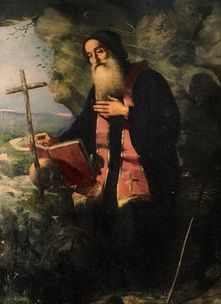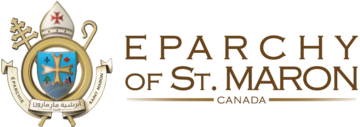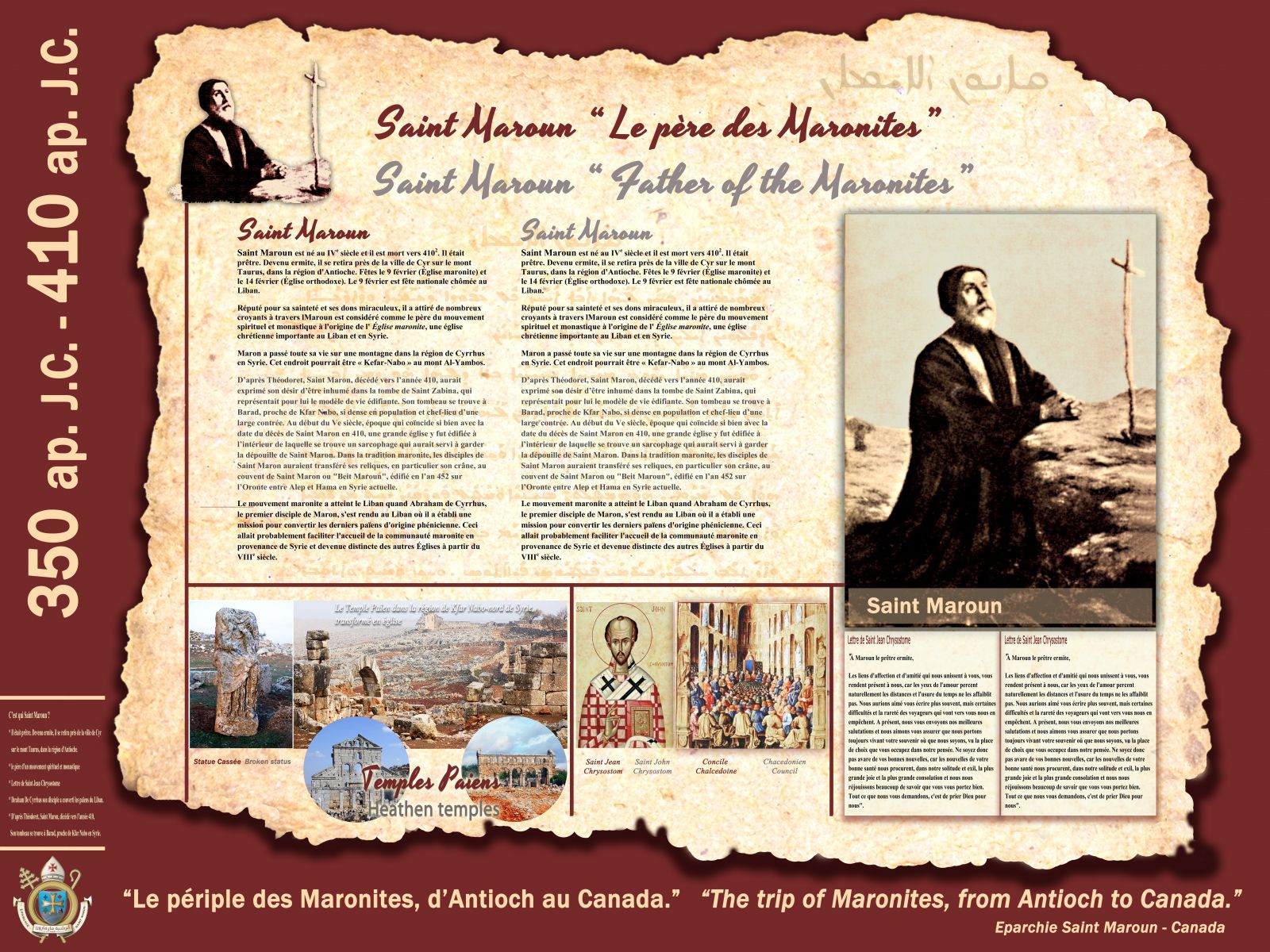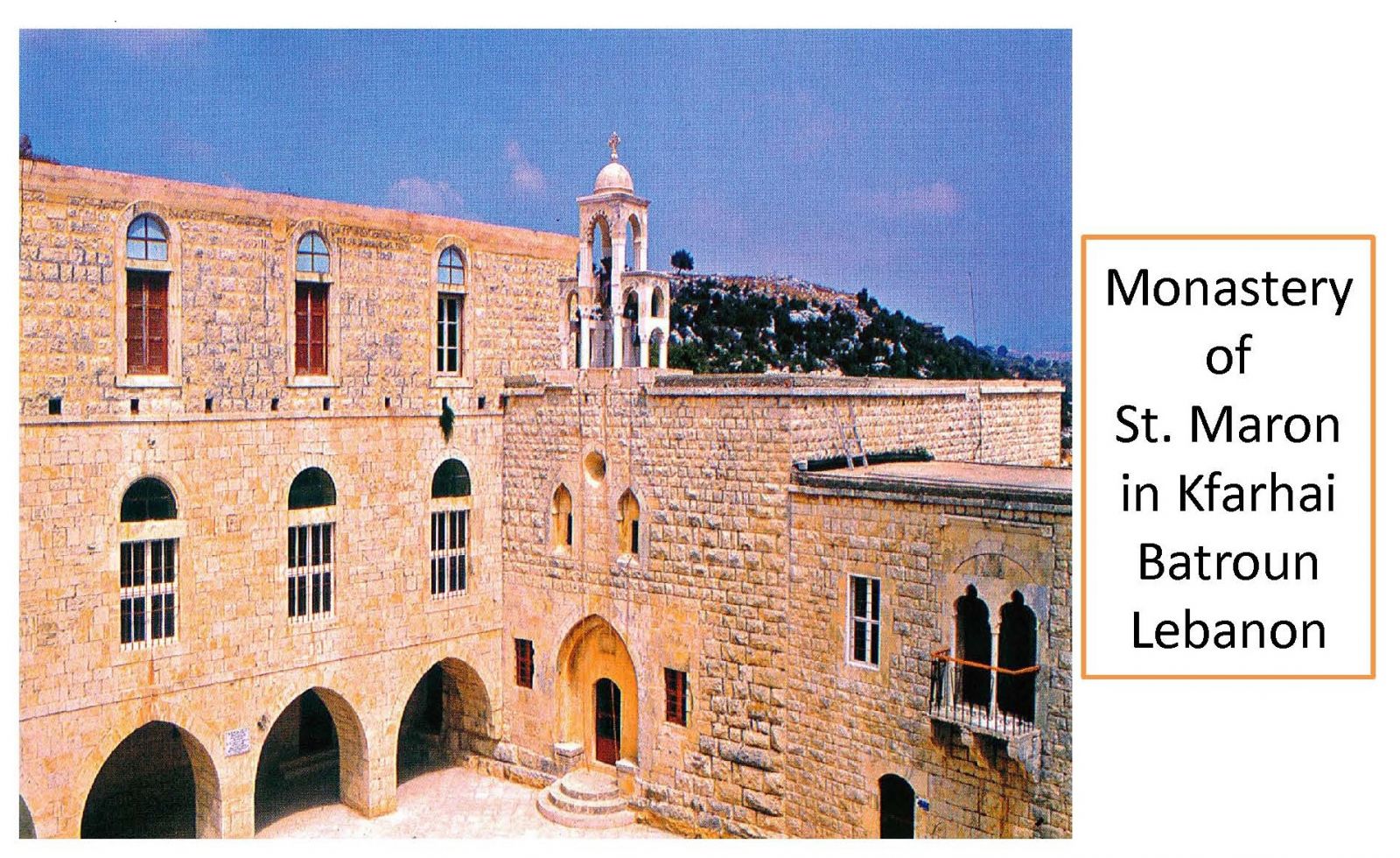Saint Maron and the Maronites
 Saint Maron, the hermit, lived in the second half of the 4th century A.D. (350-410) on “Mount Napo” in a region called “Cyrrhus”, situated between Antioch and Aleppo. He opted for life in the open air, day and night, in summer and in winter. He relinquished everything, living a life full of sacrifices, fasting and prayers. Saint Maron became famous and his holy reputation spread all over theregion. Saint John Chrysostom wrote to him from his exile in the Caucasus asking for his blessings and prayers. His bishop, the theologian Theodoret of Cyrrhus, called him “Maron the Divine” because through his prayers, he healed all who came to him with physical ormental diseases.
Saint Maron, the hermit, lived in the second half of the 4th century A.D. (350-410) on “Mount Napo” in a region called “Cyrrhus”, situated between Antioch and Aleppo. He opted for life in the open air, day and night, in summer and in winter. He relinquished everything, living a life full of sacrifices, fasting and prayers. Saint Maron became famous and his holy reputation spread all over theregion. Saint John Chrysostom wrote to him from his exile in the Caucasus asking for his blessings and prayers. His bishop, the theologian Theodoret of Cyrrhus, called him “Maron the Divine” because through his prayers, he healed all who came to him with physical ormental diseases.
Upon his death, Saint Maron was buried in a neighboring town. The locals considered his corpsea precious treasure and built a church in his name.
Some disciples of Saint Maron, mainly Ibrahim of Cyrrhus came from Cyrrhus to the mountains of Lebanon to preach to the pagans who lived in the arid areas of Byblos, Jebbeh and Batroun. They converted them to Christianity under the name of Maron. At the same time, his disciples in northern Syria, near the Apamea and around the monastery of Saint Maron on the Asi River, founded communities known as “The People of Maron” or “Beit Maron”. To escape persecutions of the Jacobins and the Arabs, they scattered around Syria and Lebanon where they settled with their relatives.
They chose the invincible mountains of Lebanon as their refuge to preserve their faith in God and their freedom to live in dignity. Once the elements of “independence” were founded, Saint Maron’s followers elected John Maron as their patriarch. They founded an autonomous Maronite Church as part of the Antiochiene Church. They continued their deployment to southern Lebanon, Cyprus, the Arab regions and other countries of diaspora, while preserving the inherited religious rituals from the founding fathers. The Maronites had a leading role in the creation of Lebanon, the homeland of the Christian mission, of values and of democracy; they were also essential in preserving it as a harbor to any oppressed or persecuted human being in his/ her journey on this earth.
John Maron Monastery – Kfarhay: Historical overview
- When he was still the bishop of Batroun, John Maron, the first Maronite Patriarch, built a monastery in “Kfarhay”, to continue the legacy of the monastery of Saint Maron in Al Rasta where monks were killed and contents were dispersed. After his election as Patriarch (685-707), he took the aforementioned monastery as his seat, carrying with him the “skull” of “Father Maron”. He named the monastery “Rich Moran” (Syriac) or “the head of our Patron (Maron)” referring to this precious relic.
- The monastery flourished, saw an increased number of monks over the years and survived there until after the Crusades. The Maronite leaders met at this monastery several times to study the concerns of their church Community.
- The monastery was more than once a subject to vandalism, pillage and destruction during the Ottoman era, due to tyranny and change of power. Each time it was rebuilt to pursue its spiritual, cultural and national influence. At the end of the 18th century, Patriarch Joseph Stephan ordered the reconstruction of the ravaged monastery. He changed its name from “Rich Moran” Monastery to Saint John-Maron Monastery.
- In 1812 the Patriarchal Synod led by the Patriarch Youhanna El Helou decided to transform the monastery into a school for the upbringing of priests. In the days of Bishop Youssef Freifer (1872-1889), the school building was expanded to accommodate laymen as well, and the school became well known. Each year, the French Consul in Tripoli used to attend the graduation ceremony there.
- The school continued to flourish with Monsignor Boutros Arsanios (1889-1909). During the First World War, it had to cease educational activities, but it kept its doors open to poor people of Lebanon and the region to provide thousands of food portions monthly. After the war, the school resumed activities with difficulties under Bishop Elias Chedid (1926 – 1950) because of the lack of human resources. In 1950, the school became a seminary for late vocations. More than two hundred and fifty priests graduated until the nineteen seventies when the seminary permanently closed.
- After the appointment of Boulos Emile Saadé as Maronite Bishop of Batroun (1986) and after finalizing the restoration of the monastery, the latter began working on returning the relics of Saint Maron to the Monastery.
The Relics of Saint Maron
- According to the Maronite tradition and Maronite historians such as Patriarch Stephan Douaihy and Bishops Youssef Semaan El Semaani, Youssef El Debs, and Abbot Boutros Fahed, the monk John Maron, who first became bishop of Batroun then the Maronite Patriarch, moved the “skull” of Saint Maron from his monastery on the Asi River to his seat in Kfarhay which was known as “Rich Moran” Monastery. He displayed the “skull” of Saint Maron so that believers get blessed from him and implore his intercession and his prayers to God.
- According to the Italian historian Ludovico Jacobilli of the town of Foligno, when one of the Benedictine princes of Oppelo, Father Michel, was the superior of the Monastery of the Cross in the region of Sassovivo (near Foligno), he visited the Holy Land in 1130 and received, in a special benediction from the monks who watched over the Monastery of Saint Maron, “the skull of the Saint”. Father Michel took the skull with reverence back to his hometown monastery and displayed it there in the church, where many miracles and healings took place.
- In 1490, the Bishop of Foligno ordered the transfer of SaintMaron’srelicsto the Cathedral of Foligno, where they were displayed on March 10th of every year and venerated in a procession around the city’s streets.
- In 1998, Bishop Boulos Emile Saadé, wrote to the Bishop of Foligno, Arduino Bertoldo, to express his interest in recovering back the relics of Saint Maron. He commissioned Monsignor Mounir Khairallah, his Vicar General then, to do the necessary follow up. After consulting with the Holy See, the Bishop of Foligno accepted to return the relicsto Lebanon where they were kept at the patriarchal Headquarters inBkerké.
- On January 8th 2000, the relics were transferred to Kfarhay, in the Eparchy of Batroun, where a great ceremony presided by Patriarch Cardinal Mar Nasrallah Boutros Sfeir was held, with the participation of the Apostolic Nuncio and many bishops. The Bishop of Folignowas also present accompanied witha delegation from his diocese. The relicswere then displayed in the church of Saint John-Maron Monastery.
- On February 9th 2017, Saint Maron Cathedral in Montreal, Canada, received part of Saint Maron’s relics. It was conserved inside an altar made of Lebanese biblical cedar at its base and of Canadian cedar at its top. The Lebanese cedar is the art work of the Lebanese sculptor and Poet Rudy Rahme. The marriage of these two kinds of wood symbolizes the relation between the Lebanese and Canadian cultures and legacies. The relic is displayed for the faithful to venerate Saint Maron.
- Today, we hope that this relic will be a source of strength and hope to follow the path of our Father Maron, so he may protect our Maronite Church and maintain it strong in its beliefs and keep Lebanon the land of faith, human values and culture of love and peace.



